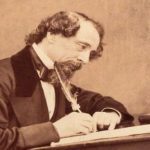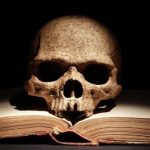 Mysteries
Mysteries  Mysteries
Mysteries  History
History 10 Surprising Stories About the Texas Rangers
 Humans
Humans 10 Philosophers Who Were Driven Mad by Their Own Theories
 Miscellaneous
Miscellaneous 10 Video-Game-Worthy Weapons and Armors from History
 Weird Stuff
Weird Stuff 10 Psychics Who Accurately Predicted Wartime Events
 The Arts
The Arts 10 Pieces of Art Inspired by a Broken Heart
 Health
Health 10 Science Fiction-Sounding New Medical Treatments
 History
History 10 Surprising Facts About the Father of Submarine Warfare
 Space
Space Ten Astonishing New Insights into Alien Worlds
 Weird Stuff
Weird Stuff 10 Bizarre Summer Solstice Rituals Still Practiced Today
 Mysteries
Mysteries Top 10 Haunting Facts About the Ghost Ship MV Alta
 History
History 10 Surprising Stories About the Texas Rangers
 Humans
Humans 10 Philosophers Who Were Driven Mad by Their Own Theories
Who's Behind Listverse?

Jamie Frater
Head Editor
Jamie founded Listverse due to an insatiable desire to share fascinating, obscure, and bizarre facts. He has been a guest speaker on numerous national radio and television stations and is a five time published author.
More About Us Miscellaneous
Miscellaneous 10 Video-Game-Worthy Weapons and Armors from History
 Weird Stuff
Weird Stuff 10 Psychics Who Accurately Predicted Wartime Events
 The Arts
The Arts 10 Pieces of Art Inspired by a Broken Heart
 Health
Health 10 Science Fiction-Sounding New Medical Treatments
 History
History 10 Surprising Facts About the Father of Submarine Warfare
 Space
Space Ten Astonishing New Insights into Alien Worlds
 Weird Stuff
Weird Stuff 10 Bizarre Summer Solstice Rituals Still Practiced Today
10 Spooky Facts about Horror Authors
The pages of horror novels are filled with eerie and gory descriptions of ghosts and monsters. But while this spookiness is strictly relegated to the page for many horror authors, for others, real life can be just as scary as their frightening fictional tales. Although neither blood-sucking vampires nor flesh-eating zombies make an appearance on this list of spooky facts about horror authors, ghosts and witches most certainly do.
Related: Ten Famous Writers Who Have Mysteriously Disappeared
10 Susan Hill Believes in Ghosts
Despite never having actually seen a ghost, The Woman in Black (1983) author Susan Hill does believe in them. In a 2019 interview, Hill said that “enough people I know have been in a place which emanates a sense of evil and have felt the urge to immediately get away from it.” She also points to dogs seemingly being spooked by unseen presences and asks, “Why would an animal make that up?”
Although a believer in the supernatural, Hill doesn’t think that every reported sighting of a ghost is true. “She believes that 99 percent of ghostly manifestations have a material explanation, but the remaining one percent cannot be accounted for in any rational way,” reports the Telegraph. While this remaining one percent is still scientifically unconfirmed, in 2016, Hill wrote that “the existence of ghosts might yet be proven by quantum physics.”[1]
9 Stephen King Is Afraid of the Number 13
Over the years, Stephen King has terrified countless people with his horror novels, which are full of vampires, ghosts, and supernatural cars. But what really scares King himself is the number 13. In a 1984 New York Times article, King wrote about his phobia of the number, which is known as triskaidekaphobia. He pointed out that 1984 was a particularly unlucky year because it had three Friday the 13ths, the maximum amount that a year can have.
“I always take the last two steps on my back stairs as one, making 13 into 12,” King goes on to write. “When I am reading, I will not stop on page 94, page 193, page 382, et al.—the digits of these numbers add up to 13.” Although he admits that this behavior is neurotic, he would rather be safe. This phobia later worked its way into King’s writing. His 1999 short story 1408 is about a haunted hotel room located on the 13th floor (although listed as the 14th floor), and if the digits of the room number are added together (1+4+0+8), they equal unlucky number 13.[2]
8 Algernon Blackwood Was a Member of the Ghost Club
Algernon Blackwood is best remembered for his 1907 novella The Willows, which is about two men taking a boat trip down the Danube River and encountering otherworldly entities. Blackwood’s interest in the supernatural extended well beyond just his literary output, though, as he explored different forms of mysticism and the occult throughout his life.
He investigated Kabbalah, a type of Jewish mysticism, and Theosophy, a religion that believed in reincarnation and karma. He also sought out the supernatural in non-religious forms. He was a member of the Hermetic Order of the Golden Dawn, an organization dedicated to magic. He also joined The Ghost Club, a group that explored paranormal activity and counted within its ranks writers such as W.B. Yeats, Arthur Conan Doyle, and Charles Dickens (who remained unconvinced of the existence of ghosts).[3]
8 Anne Rice Believed She Lived in a Haunted House
Interview with the Vampire (1976) author Anne Rice didn’t actually believe in vampires, but she did believe in ghosts. Rice’s literary career enabled her to buy a few mansions in her native city of New Orleans, and she believed that one of them was haunted. Rice told NPR that her Rosegate Mansion, a lavish antebellum-style house at 1239 First Street, “has legends. It has ghosts.”
She went on to say, “I don’t see them, but other people have seen them.” The ghost of Pamela Starr Clapp, who lived in the mansion for most of her life before dying there in 1934, allegedly haunts the grand home. She isn’t the only one said to have died on the property either: A man supposedly shot himself on the staircase.[4]
6 Edgar Allan Poe Died in a Mysterious Way
To this day, the exact cause of Edgar Allan Poe’s death remains a mystery, one that feels fitting of the writer’s own macabre tales. The story begins on September 27, 1849, when he left Virginia and headed to Philadelphia. But he never arrived and was instead found in Baltimore six days later in a confused state and wearing soiled clothes that were not his own. In a letter requesting help from one of Poe’s friends, the man who found him said he was “rather the worse for wear” and “in great distress.” His friend then described him as “haggard, not to say bloated, and unwashed, his hair unkempt, and his whole physique repulsive.”
Poe spent the next few days suffering hallucinations in the hospital and calling for an unknown person called Reynolds before dying on October 7. Doctors couldn’t figure out what was wrong with him. Many theories have since been put forward to explain his bizarre final days and death, including a brain tumor, murder, rabies, and cooping—a form of voter fraud where victims were kidnapped and forced to vote for a particular candidate by being beaten and/or plied with alcohol.[5]
5 M.R. James Wrote about His Own Paranormal Experiences
M.R. James was a master of the ghost story, and it’s thought that his fascination with the paranormal may have stemmed from an incident in his childhood. “A Vignette” was the last story he wrote before his death. It was likely autobiographical in nature, having a confessional tone and matching the setting of his childhood home, the Livermere Rectory, which sat on the edge of a supposedly haunted woodland.
The narrator recalls being a young boy and seeing something through a hole in the gate to the garden. He goes to take a closer look and sees a “malevolent” face staring back at him through the hole, but says it is “not monstrous, not pale, fleshless, spectral.” Rather, it is described as “pink,” and “the whites of the eyes all round the pupil” could be seen. He flees in terror and, on looking back, sees “a draped form shambling away among the trees.”[6]
4 H.P. Lovecraft Was Afraid of Large Enclosed Spaces
Not long before his death, Cthulhu Mythos creator H.P. Lovecraft wrote about his fears in a letter to Harry O. Fischer. “I know about claustrophobia & agoraphobia, but I have neither. I have, however, a cross betwixt the two—in the form of a distinct fear of very large enclosed spaces,” he explained. This phobia, which he didn’t know the name of, is called kenophobia.
Lovecraft then gave a few examples of his fear: “The dark carriage-room of a stable—the shadowy interior of a deserted gas-house—an empty assembly-room or theatre-auditorium—a large cave.” He also pondered the reason that these spaces scared him and attributed it to the “black abysses of my infant nightmares.” This lifelong fear worked its way into many of his horror stories. Incidentally and hilariously, Lovecraft signed off this letter as “Grandpa Cthulhu.”[7]
3 Shirley Jackson Claimed to Be a Witch (and Had a Spooky Sleepwalking Experience)
Rumors that Shirley Jackson was a witch started with the author’s biography on her first novel, The Road Through the Wall (1948), which claimed that she was “perhaps the only contemporary writer who is also a practicing witch.” Although written in jest, this claim took on a life of its own, one which Jackson often encouraged. In an author profile for the Associated Press, W. G. Rogers wrote that “Miss Jackson writes not with a pen, but with a broomstick.” She also jokingly said that she had cast hexes on publisher Alfred Knopf and on rivals of the Brooklyn Dodgers baseball team.
As well as encouraging the rumors, Jackson also had hundreds of books on witchcraft in her home library, and in 1956, she even published a book about the Salem witch trials. But her interest in witches never actually extended beyond the scholarly and literary.
Although black magic may not have been a part of her real life, she did have a scary sleepwalking experience while writing The Haunting of Hill House (1959). In an essay in Come Along with Me (1968), she writes that she awoke one night to find the words “DEAD DEAD” written on a piece of paper in her own handwriting. She comments that the note motivated her to “write the book awake, which I got to work and did.”[8]
2 Peter Watts Contracted a Flesh-Eating Disease
Although usually categorized as a sci-fi writer, many of Peter Watts’s stories have a strong horror element to them. For instance, Blindsight (2006), his best-known novel, is basically a haunted house story set in space, and it even features a vampire as a character. In 2011, Watts contracted a grim disease called necrotizing fasciitis, which is commonly known as the flesh-eating disease. In a blog post, he wrote that he nearly died from the disease and had been left with “a crater the approximate size and shape of Australia carved out of my right calf.”
Despite his extended stay in the hospital, Watts still managed to find humor in the gory situation. “If there was ever a disease fit for a science fiction writer, flesh-eating disease has got to be it. This f***er spread across my leg as fast as a Star Trek space disease in time-lapse.” For those with a strong stomach, progress pictures of his infected leg can be seen on his blog.[9]
1 Mary Shelley Kept Her Husband’s Calcified Heart (and Probably Had Sex in a Graveyard)
When poet Percy Bysshe Shelley died in a storm at sea in 1822, his wife, Frankenstein (1818) author Mary Shelley, kept an unusual keepsake from him. His remains were cremated, but strangely, his heart was not reduced to ash. Physicians have suggested that this may have been because it was calcified by a tuberculosis infection. Whatever the reason, the charred heart was snatched up and eventually given to his grieving widow.
Shelley held onto the heart of her deceased husband for the rest of her life. Upon her death, the couple’s son, Percy Florence Shelley, cleared out her desk and found the heart of his father wrapped in one of his last poems, “Adonais” (1821), which laments the premature death of John Keats. Percy Florence requested that upon his death, the heart be buried in the family vault, where it rests to this day.
Mary and Percy’s relationship is also rumored to have had rather a macabre start. Mary’s mother, women’s rights advocate Mary Wollstonecraft, died soon after giving birth to her daughter. Growing up, Mary spent time a lot of time at her mother’s gravestone in Saint Pancras’ Churchyard and frequently took Percy there when they were courting each other. Scholars, therefore, believe that it is very likely that Mary lost her virginity to Percy at her mother’s grave.[10]








